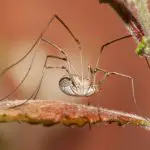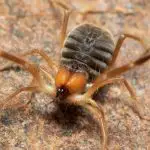Last updated on July 5th, 2023 at 03:11 pm
It’s not often that an arachnid is weird and cute, but this one certainly pulls it off! Keep reading to learn some fascinating Bunny Harvestman Spider facts…
Deep in Ecuadorian rainforest dwells a critter that appears to have sprung out of a book about mythical beasts and supernatural creatures. The little Bunny Harvestman, which resembles head of a black hare or perhaps a dog, looks menacing yet curiously charming at the same time.
Metagryne bicolumnata
Metagryne bicolumnata, also known as bunny harvestman or daddy longlegs, belong to the order Opiliones. Despite being arachnids and phenotypically resembling spiders, Bunny Harvestman Spiders are more closely linked to scorpions and camel spiders.
Harvestman have existed for at least 400 million years and are believed to have lived even before dinosaurs. Bunny Harvestman Spiders are found in more than 6,650 different species worldwide. And fossil records indicate that they have existed for a very long period.
With eight gangly yellow legs spreading out from a small circular torso, witnessing it move is truly amazing since it moves as if on stilts. It is speculated that its dark, enigmatic shape is to make it appear larger and more dangerous to predators.
However, Harvestman hasn’t undergone much research, and scientists don’t know for sure why its body is shaped the way it is.
And thus, Bunny Harvestman Spiders is still somewhat of a fascinating mystery.
Where does the bunny harvestman spider live
The Ecuadorian Amazon rain forest, one of the biodiverse regions of the globe, is the place where the Bunny Harvestman Spiders makes its home.
During warm temperatures, they are typically found under logs, caves, crevices, leaf piles and under rocks in both rural and urban environments; they love damp and moist environments. They don’t have the ability to spin and weave silk, so they do not reside in webs too.
Typically, a harvestman can be observed resting still on the upper surfaces of leaves, preparing to attack a soft-bodied insect.
The majority of Bunny Harvestman Spiders are essentially the same, while certain species may inhabit more arid areas.
Note: If you want to learn absolutely everything there is to know about the fascinating world of Harvestmen, I suggest checking out the book below:

Bunny harvestman spider size
About the size of a human fingernail, a Bunny Harvestman Spiders measures no longer than half an inch. The segmented legs and unsegmented torso of these tiny arachnids contrast with their diminutive size.
When observed from a certain angle, the big black bump on their backs, which has two spots and two spikes, resembles the head of a rabbit or a dog which is their main characteristic.
Size, color, and appendage proportions can all be used to distinguish between male and female. Generally speaking, the male’s body is smaller, shorter, and more vividly colored than the female’s, but the latter’s markings are more pronounced.
The granulations and spines on the male’s legs are more pronounced.
What do Bunny Harvestmen eat?
Bunny Harvestman are generally omnivorous. Harvestmen are predators and scavengers who consume a variety of foods,
Harvestman prefer to devour mostly decaying plant and animal materials instead of pursuing only prey like spiders do. Additionally, they may eat snails and other tiny invertebrates.
Food is never an issue; it can also be anything from fungi to aphids, beetles, caterpillars, earthworms, flies, mites, small slugs, snails, and spiders. Watch one feed and note how it draws each leg through its teeth one at a time to clean them after each meal.
Due to their nocturnal nature and propensity to easily become dehydrated, they frequently seek out water and spend a lot of time sleeping to conserve energy.
Do harvestmen have fangs?
Harvestman lack fangs or any other means of chemically subduing their prey or food.
Instead of huge, hollow spears tethered to a large venom gland, Harvestman have segmented mouth like fangs called chelicerae that end in tiny pincers. Like a pair of dull stitching scissors, these mouthpieces are intended to delicately chop food into bits that will fit into their mouth hole.

What are the its predators?
Being tiny can make it more difficult to survive in dangerous, harsh situations.
Many creatures, including certain mammals, amphibians, birds and other arachnids like spiders and scorpions, are among the Harvestman’s predators.
Nevertheless, they are equipped with a number of cunning strategies for self-defense:
- At the base of their front legs, they contain pores that produce an offensive odor. They are shielded from hungry predators by this odor.
- They also adopt an autotomy technique in which they separate one leg from their body in order to fool a predatory animal.
- The ability to freeze in position and blend in with the surroundings is another form of defense. This deceives their feeding into thinking they can see right through them.
Can harvestman regrow legs?
Compared to other arthropods that have legs that grow back after molting, Harvestman Spiders do not have legs that regrow even if they are severed before reaching maturity.
They examine their surroundings for opportunities to maneuvre and anticipate danger with the help of special sensing organs on their front legs or the countless microscopic hairs that cover their legs. The seven joints on the harvestmen’s legs are incredibly unusual.
The lengthier, second pair of their 4 pairs of legs incorporates the perceptions of taste, touch, and smell.
They move slowly most of the time, but they are capable of moving quickly when they swing their bodies beneath their pumping “knees.” They balance on six legs and flap the second pair in the air to detect disturbances by utilizing their surroundings.
The surface tension of the water holds Harvestmen’s feet, despite having legs as fine as water striders’. This prevents them from moving beneath the water’s surface.
Harvestmen don’t walk with their bodies raised very high off the earth. The middle of their legs are raised high in the air while they carry it low.
Bunny Harvestman Spiders frequently groom themselves, paying particular attention to their legs. They are good as dead if they lose both of their sensory legs, which they can do to flee from predators.
Bunny harvestman spider for sale
As of yet, no Bunny Harvestman Spiders are retained for sale. However, people frequently keep other Harvestman species as pets.
There are also many gifts and products that draw inspiration from Harvestmen.
Can harvestman bite humans?
Harvestman are not thought to pose a threat to homes and are not known for biting people. They do not have the potential to produce venom.
They are not pests and are extremely helpful and medically safe. Although a large grouping of them occasionally becomes a nuisance, keep in mind that they pose no threat to people, animals, buildings, or crops.
Rarely, rather, they appear to gnaw and scrape at things before eating the small pieces that fall out.

FAQ relating to Bunny Harvestman Spider facts
Is a bunny harvestman spider poisonous?
Bunny Harvestman are not poisonous. They belong to the order Opillones and is not a true spider. However, they have the capability to molt regularly.
They have no venom glands, in spite of their scary appearance, making them absolutely harmless to humans.
What is a bunny harvestman?
The Bunny Harvestman is a species of arachnid, also called “daddy longlegs,” “harvestmen,” “Opiliones” or “harvesters.” German arachnologist, Carl Friedrich Roewer made the first observation in 1959.
The Opiliones are a separate order that is not closely related to spiders, despite having superficial similarities to and being frequently mistaken for spiders (order Araneae). The exceptionally lengthy legs of Bunny Harvestman Spiders have earned them the nickname “shepherd spiders” because they reminded onlookers of how some European shepherds utilised stilts to better view their roving flocks.
How long can a harvestmen live?
A harvestman spider has an average life span of several months to a year or longer. The typical harvestman molts every ten days.
Harvestmen undergo a partial metamorphosis. They mate throughout the late summer and early fall, copulating easily whenever they come into contact.
When a male and female spider directly mate, the male spider’s sperm is transferred to the female spider. During the late summer to early fall, the eggs are laid in groups of up to 120 and hidden beneath stones, in cracks in the ground, under moss, or inside rotting wood.
Eggs can hatch in as little as 20 days or as long as 6 months. Opilionids typically have a single generation each year and are slow reproducers.
Some harvestmen have parthenogenetic reproduction, which allows the females to have progeny without the males.
How many eyes does a harvestman spider have?
In contrast to spiders, which often have six or more eyes, harvestman spiders have two tiny eyes on top of their torsos. Adding to the strange image are two additional bright neon yellow spots that are neatly situated where a bunny’s eyes would be.
In fact, the rabbit harvestman spider’s true eyes are located lower down, at a protruding point with eyeballs positioned on either side of the bump. But without someone pointing it out , it would be pretty challenging to understand this particular aspect.
The appearance of a nose is also given off by this bulge, which strengthens the impression of a rabbit head.






